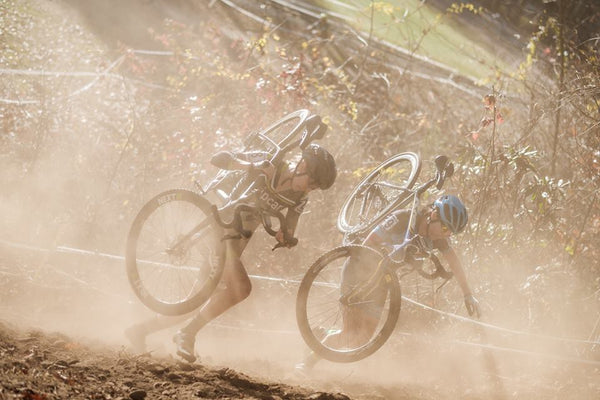by Daniel Matheny

Cyclocross season is here! If you aren’t a diehard crosser, the season may have snuck up on you. But, not to worry, there is still time to hone your existing fitness to the demands of cyclocross racing. Coach Daniel Matheny shares his cyclocross training overview and a few workouts to get you on course.
Cross is a dynamic sport that involves all the energy systems involved in cycling, but often there’s a misconception that it’s predominantly “an all-out sprint for 30 to 60 minutes.”
Well, first off, you can’t sprint for more than a handful of seconds (effectively, I might add) and if you are, it’s not really sprinting, as your body exhausts the ATP-PC system after 8 to 12 seconds. In reality, you rely more heavily on the glycolytic and aerobic systems for cyclocross.
Whoa whoa, what is all this science-y stuff, you ask? Here’s a quick run-down. (If this isn’t sufficient, there are plenty of articles out there on energy systems.)
ATP-PC/Anaerobic
- quick energy delivered
- immediate metabolic step
- usually depleted with 8 to 12 seconds of max effort
-
constantly being replenished by other systems but requires much greater rest period to fully replenish (3 to 5 minutes)
Glycolytic (or Lactic system)
- moderate energy delivery for moderate time (20 seconds to a few minutes)
- moderate number of metabolic steps producing 2 ATP
- ramps up after the 5 to 10 seconds of ATP-PC system depletes
- fueled by glucose/glycogen, which we store limited amounts (~1500-2000 kcal worth)
Aerobic system
- slow energy delivery but produces much more than other systems
- many metabolic steps producing 30-32 ATP
- ramps up after a few minutes, when the formerly mentioned energy systems are depleted
- utilizes fat, carbohydrate and protein as fuel
- Nearly unlimited energy since even lean individuals store 90,000+ kcal from fat which would fuel 150 one-hour rides for an average 600kJ/hr output!
What does this all mean? Cyclocross is demanding, with large variances – from powering up a steep switchback that requires high force at low cadence to carrying speed into the bottom of a run-up with high force and high cadence. Thus the power output is much more stochastic, but that’s talking muscle recruitment. (We’ll save that topic for another day).

Your body takes all of these repeated surges – powering up steep run-ups and bounding over barriers – as a perceived steady state effort, kind of like a 20-40km TT.
It’s worth pointing out that energy systems aren’t like a light switch. It’s not On or Off. Think about them more like 3 dimmer switches to get the mood lighting just right for the demand.
You’ve got to take off hot to get in a good position, so you use that ATP-PC to clip in and go. But you quickly realize you aren’t sprinting like Mark Cavendish, so your body starts utilizing the glycogen in the glycolytic system, as your surge off the line settles into a supra-threshold effort. You can only hold for so long before either your reach peak oxygen consumption and blow up or settle in (the smart thing to do) and resort to racing.
Settle in?!?! I don’t know about you, but for me there isn’t much sitting in or recovering during a cross race. 'Settling in' instead refers to reaching a somewhat of a steady state output and thus steady heart rate. This is by no means easy and often feels as though you have blood bubbling up in your eye sockets.
You do get micro-recoveries, however, while setting up for and during cornering as well as on some downhills. Otherwise you are keeping it pinned, utilizing little bursts of ATP out of corners, as it replenishes slightly with the micro-recovery, or utilizing glycolysis as you bridge a gap, attack or charge into a headwind or sustained uphill drag. You have to be on your A-game for 30 to 75 minutes, depending on your race category.
With these high-intensity demands, a byproduct of hydrogen ions (H+) peak, usually around 4 minutes. It’s termed acidosis and it interferes with other muscle processes. This is the fatigue you feel if you stay on the gas a bit too much and start to burn. It's theorized that this acidosis of H+ may be more of the cause of so called “burn” than the misnomer of lactate which is actually recirculated to produce more energy.

This is where Beta Red Pre-Workout Formula comes into play. Beta-alanine, a key ingredient, has been shown to be a major contributor in hydrogen buffering. It helps delay acidosis, which mean you can stay on the gas longer. Another key ingredient, beet juice, lowers your perceived effort. This benefits you with efficiency gained from the start, thus improving your threshold. By not burning as hot off the line, Beta Red is working two-fold to make you more efficient.
Here are some tips to get the most from your cross workouts:
1) Don’t forget the steady state threshold work. Many athletes only focus on the repeated high-intensity punches and as a result their efficiency for sustained work is lacking before the end of cross season.
Try this: 3-6x10min threshold pace, 5 min of rest between.
2) If coming off a good fitness summer, don’t negate the specificity of cross, demanding repeated supra threshold efforts with limited recovery.
Try this: 4x8min or even 4x15min, repeat 20sec above threshold & 20sec at aerobic pace, with short 3-5min rest between.
3) If you want to see how a cyclocrosscross effort feels, do a race simulation workout.
Try this: After a warm up, start from a stand-still, accelerate fast and hold above threshold for 2-3min, then settle into a sustainable tempo pace for 20-45min that includes standing surges for 10sec each 2min.


Leave a comment